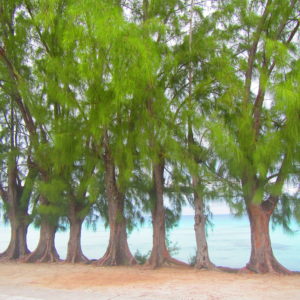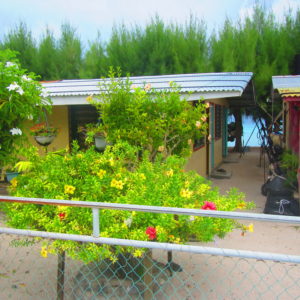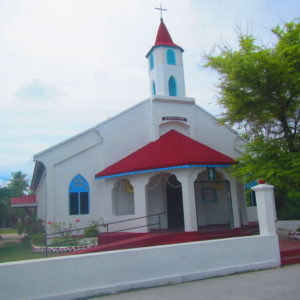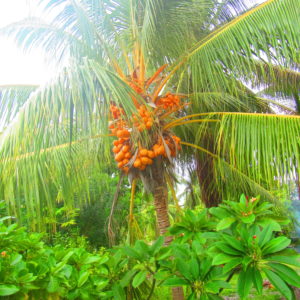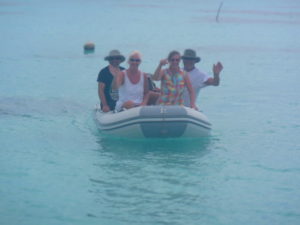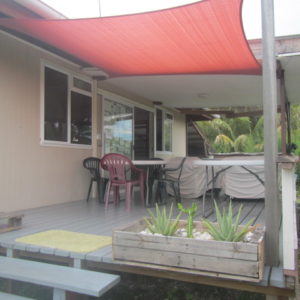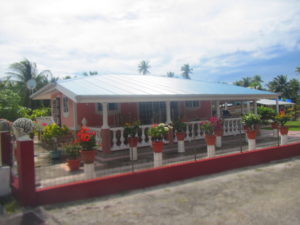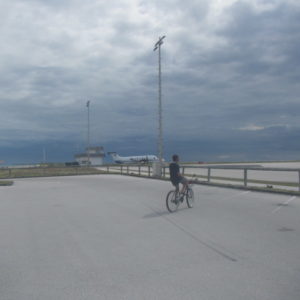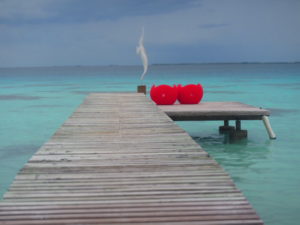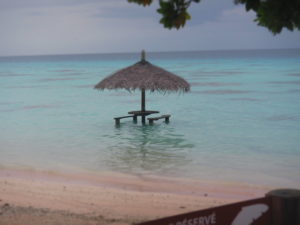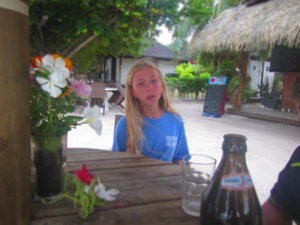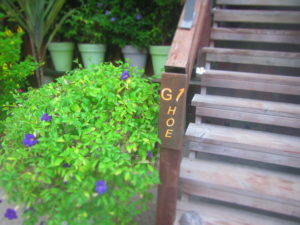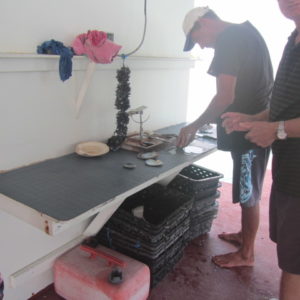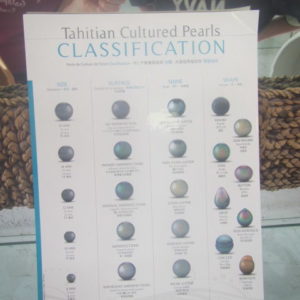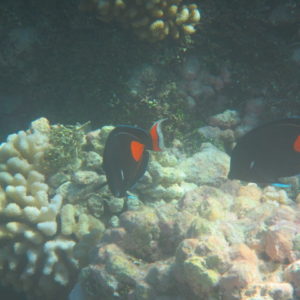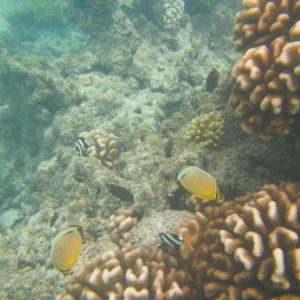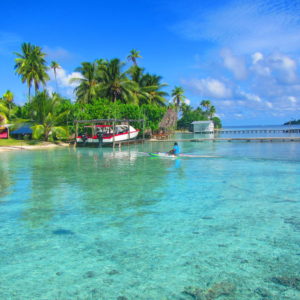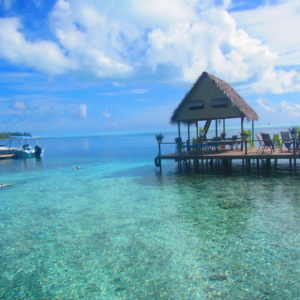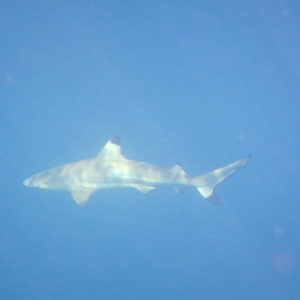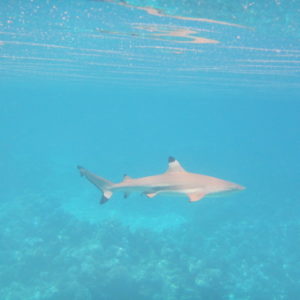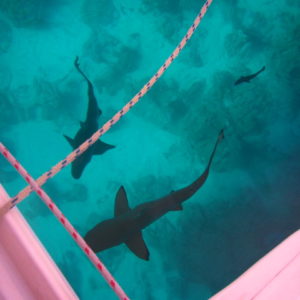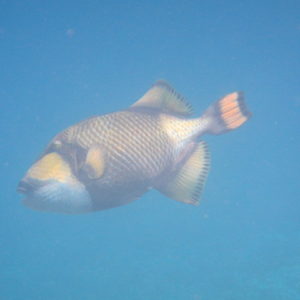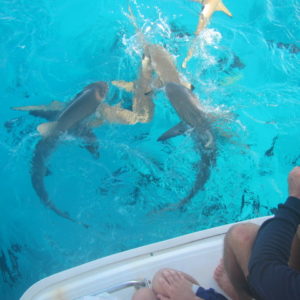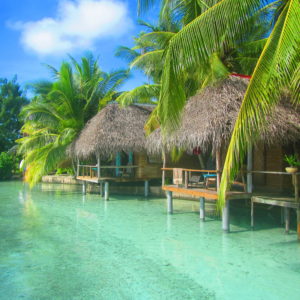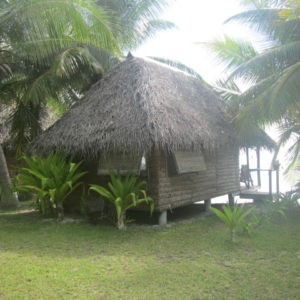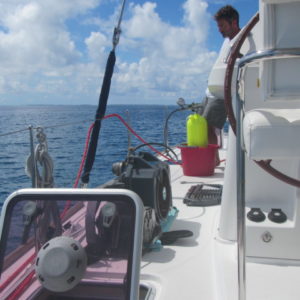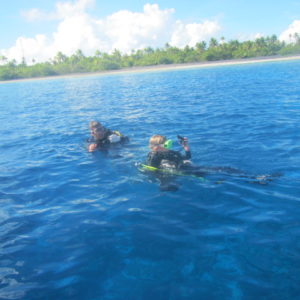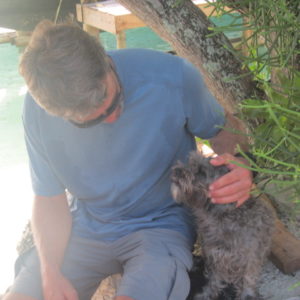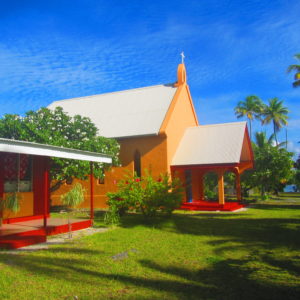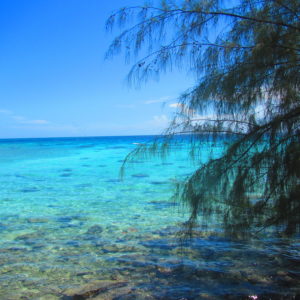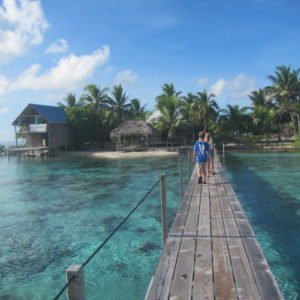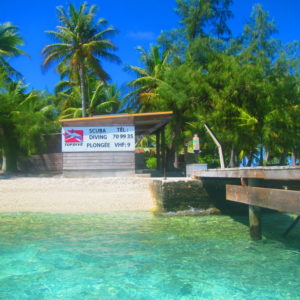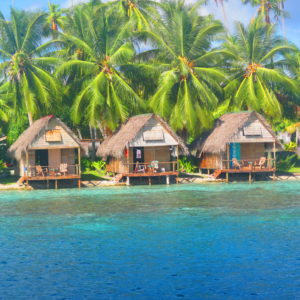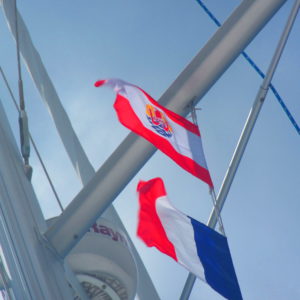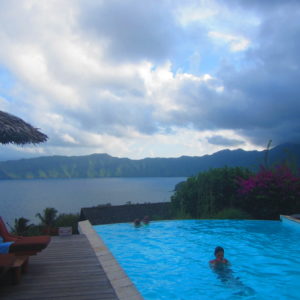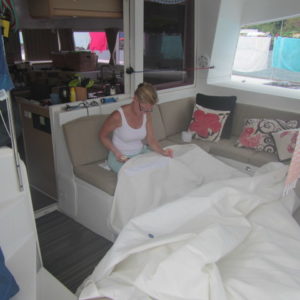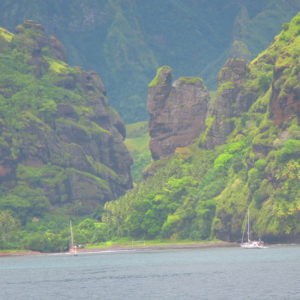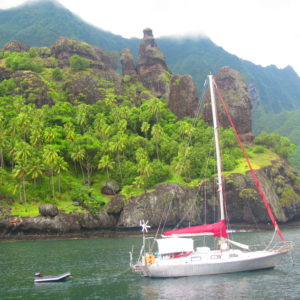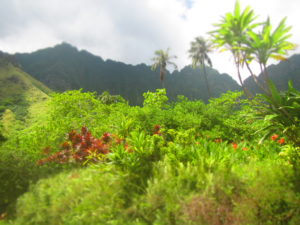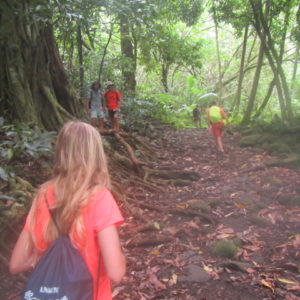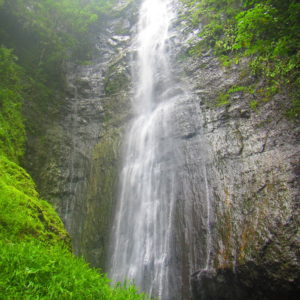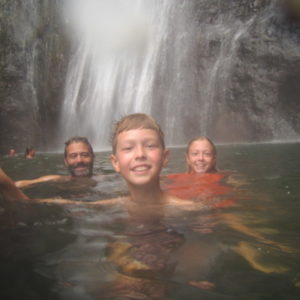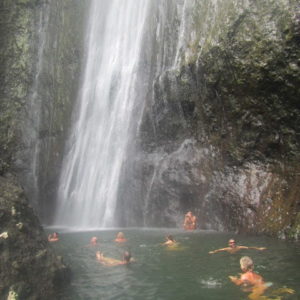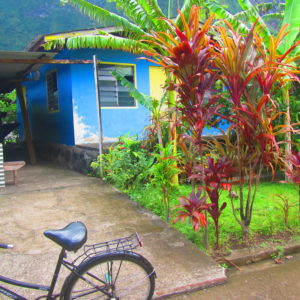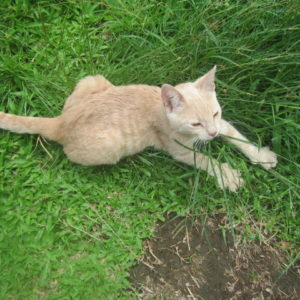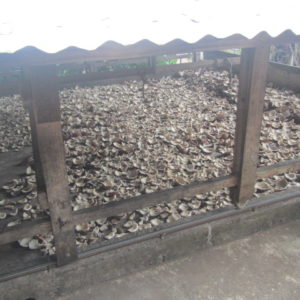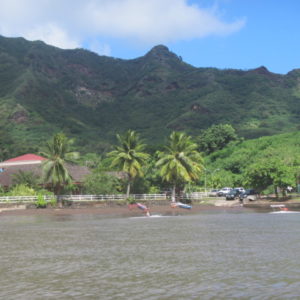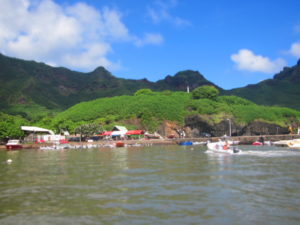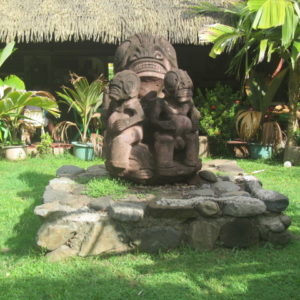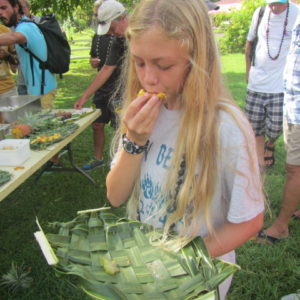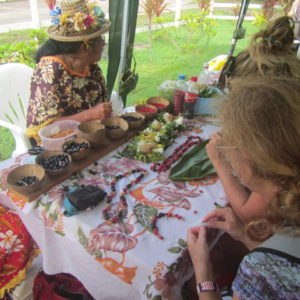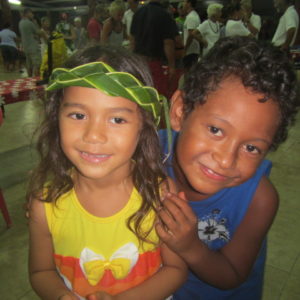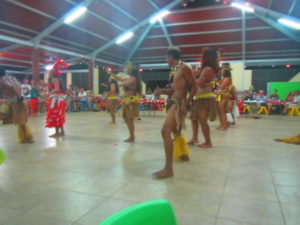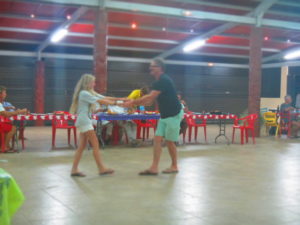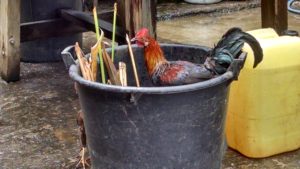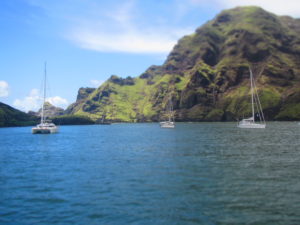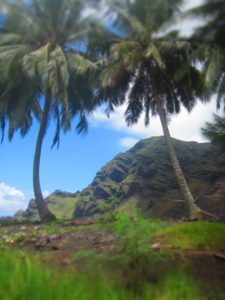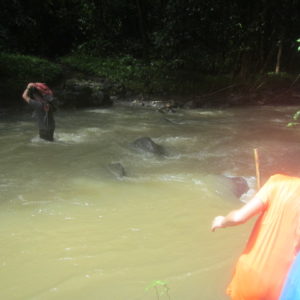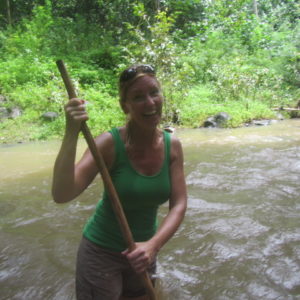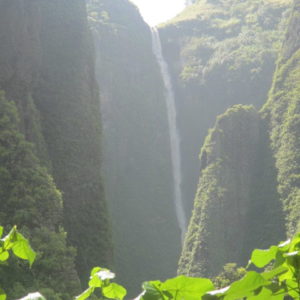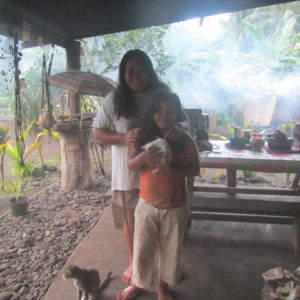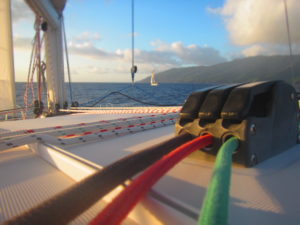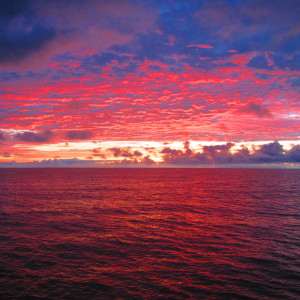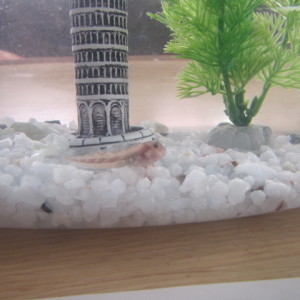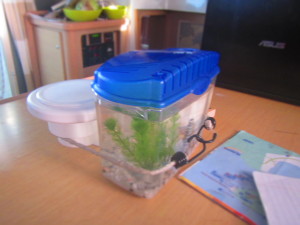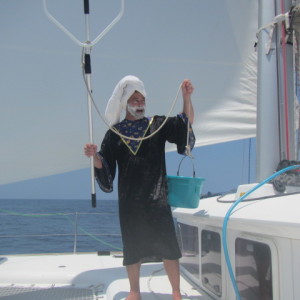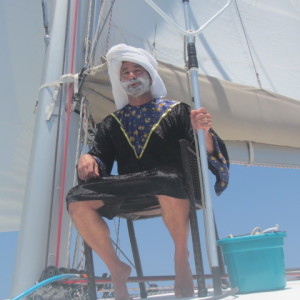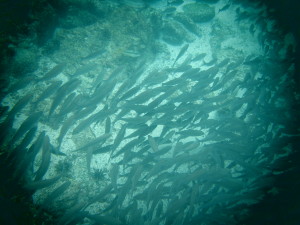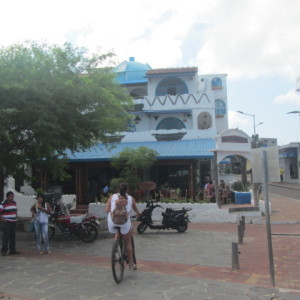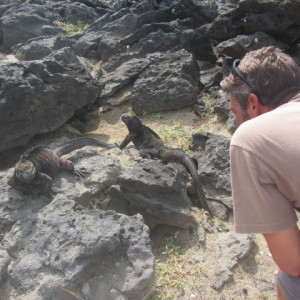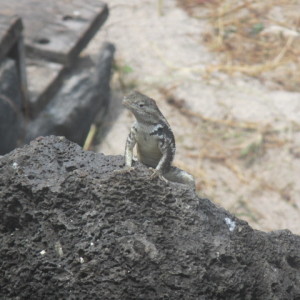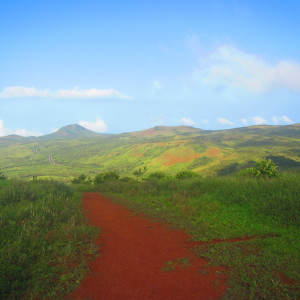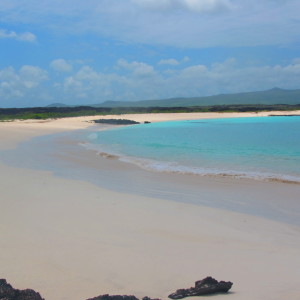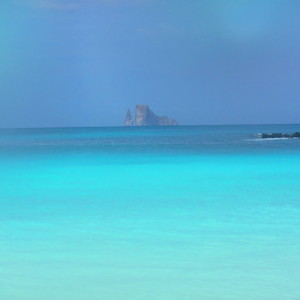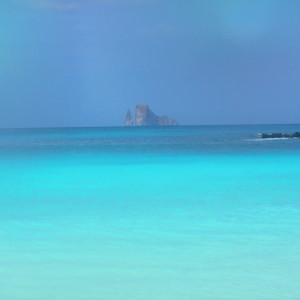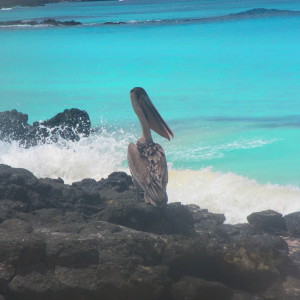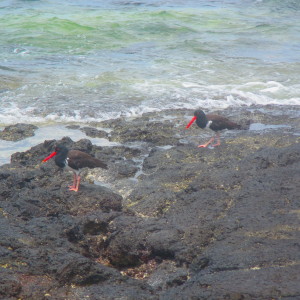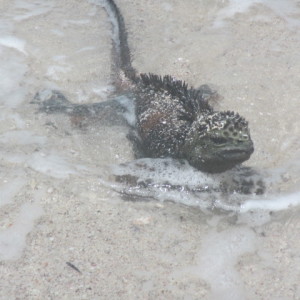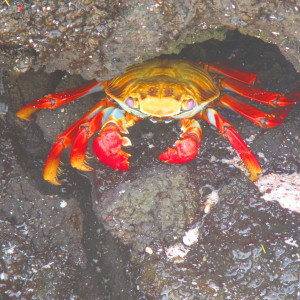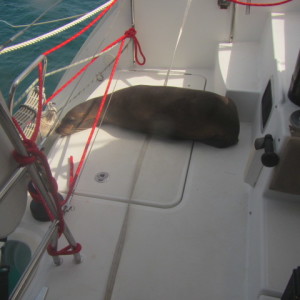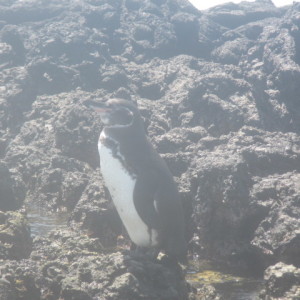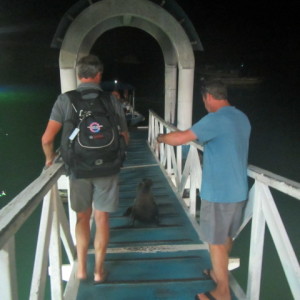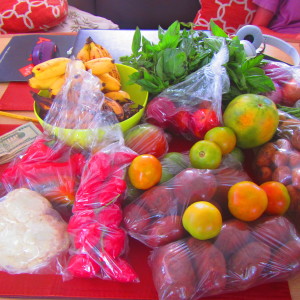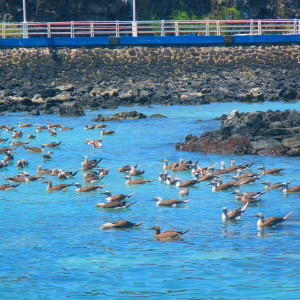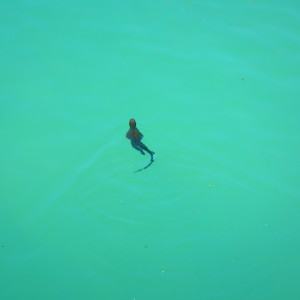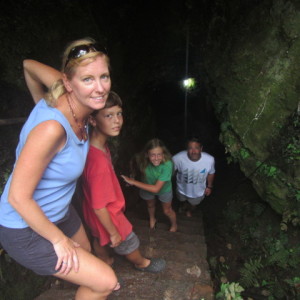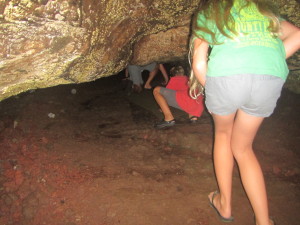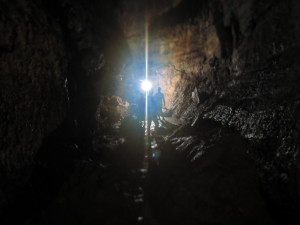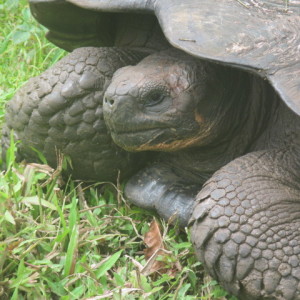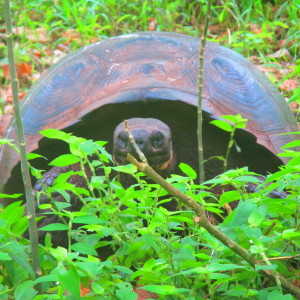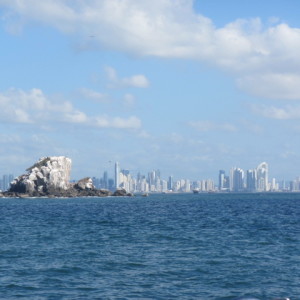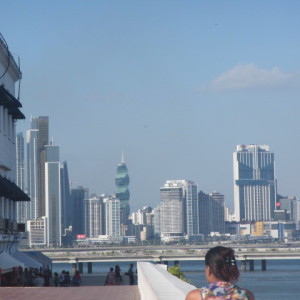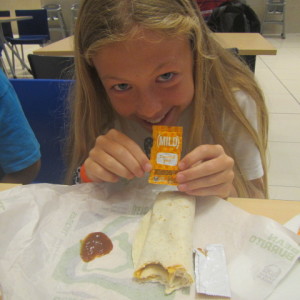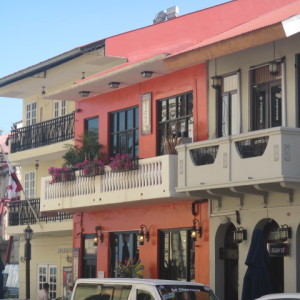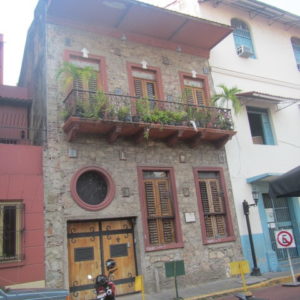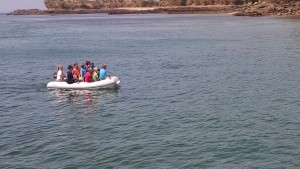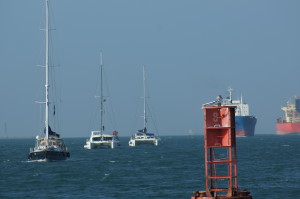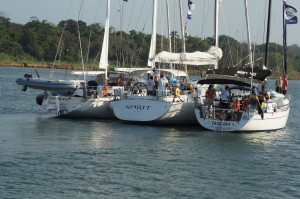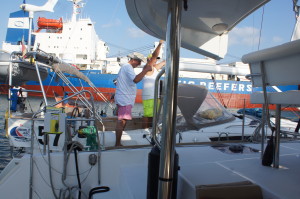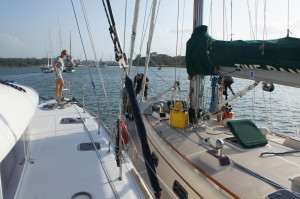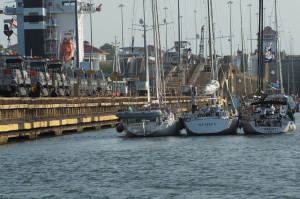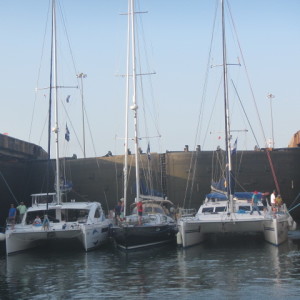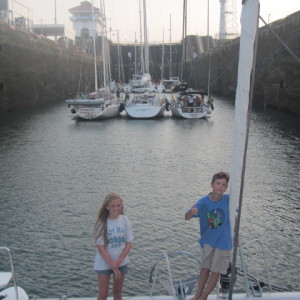We made the decision to leave the ARC as of Tahiti because the pace is just too fast for us at this point. We cannot sail from Fiji to New Zealand until after cyclone season, so we have until the end of October to enjoy all of the islands in between Tahiti and Fiji. Fortunately, there are several other boats who are jumping off of the ARC as well, so not only will we have greater opportunity to meet other cruisers, but we also have some folks we already know and like who will be traveling on much the same path. We are still trying to nail down which islands we will go to, but it looks like we will most likely take the northern route after the Society Islands. We were originally thinking we would go south to the Cook Islands, but the weather on that route is more volatile and you have to be ready to depart the one Cook Island we would have gone to (Rarotonga) if the weather gets bad—and there is really no other place to go. Also, despite the fact we have heard American Samoa is not very pretty and not worth the effort, we may go there to receive delivery of all of the kids’ school materials for next year so we can avoid the steep customs charges. Since we are American, we are exempt from the duty fees in American Samoa (at least we think so; we will have to confirm that). That little side trip will probably save us about $1,000. So, this means we will hit Suwarrow, American Samoa and then head to Tonga and Fiji. Prior to that, we still have several islands to go to here in the Society’s: Huahine, Tahaa, Bora Bora, Maupiti, and possibly some others. I already prefer the Society Islands over the Marquesas, so we will definitely be taking our time here. (The Tuamotus are also VERY high on my list of favorite places so far.)
Author Archives: Paula
Fakarava Drone Video
Here is Fakarava all in one…with GoPro Drone Footage…
The Tuamotus
North Fakarava
Fakarava, Tuamotus
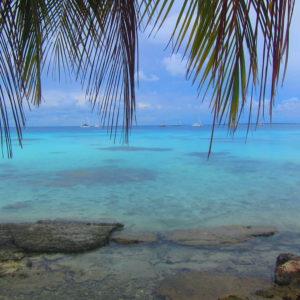
Our sail to the Tuamotus took us four nights and was relatively uneventful. But, looking at our Yellow Brick position, people would have thought we were still in the middle of the ocean when we arrived; these islands are like specks in Horton Hears a Who. Heck, I had never heard of them before this trip, and I had no idea what to expect. The repairs I stitched on the jib continued to hold up and our newly-fixed Genniker was much appreciated on this sail. We were headed specifically for Fakarava Island, which is actually classified as a Natural Biosphere Reserve by Unesco. We were headed for the land of exceptional scuba diving—yippee!
The Tuamotus are somewhat strange for cruisers. They have “cuts” in the atolls at a few places, and that is how you make it into the protected middle. The land itself is not wide at all but goes around nearly completing a circle. You have to be careful entering these cuts because if the tide is coming out, the current can be very strong, and your engine(s) won’t be able to get you in there. Also, the waves can be very large as well in some of these passages. We entered Fakarava’s north cut at the proper tide time, and this cut turned out to be quite easy.
The name of the town at the northern pass is called Rotoava. It is a nice little village with a few restaurants, some pensions, two small grocery stores, some artisan craft stores, a Tahitian pearl jewelry shop (the woman makes her own jewelry), a few dive shops, a handful of pearl farms and a small airport. There is also a Yacht Services Company that is owned and operated out of the home of a nice French family with two young girls. They rent bicycles, sell sodas and fresh juices, and allow cruisers to use the Internet on their home’s deck. That is essentially the extent of the town. One night we tried to have dinner at a restaurant and the power went out in the entire village! Left with few menu options, we opted to return to the boat and cook. The good part about living on a boat—power when land doesn’t have it! We eventually ate at this restaurant which really only served paninis and crepes. There was also a woman on the island who would make you pizzas out of her house for $12 each (individual-sized) but we never could find her house and you had to order early in the morning for an evening pick-up. The only other restaurant in walking distance was very good, and you could get two nice pieces of seasoned, grilled tuna with French Fries (with Garlic Butter) for only $10. Not bad! They had steak and fries too for $10, and salads that were pretty good.
Rotoava, Fakarava
Nina: Steve, Lynda, and their crew, Peter and Karen
Lunch at one of the few restaurants on the island
Fakarava Yacht Services (at Stephanie and Aldrich’s house)
The house of an owner of a pearl farm
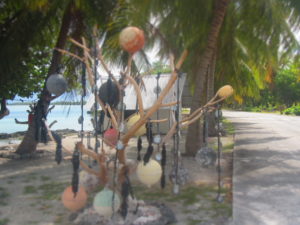
The Fakarava Airport
A day out exploring on bikes
Tiny hermit crabs
There was a nice pension we rode our bikes to as well. They had a snack bar on the water and a very nice atmosphere. They had a “fancy” restaurant at night, but I am not sure if anyone ever ate there. There were two small grocery stores on the island and I was able to get grapes and yellow watermelon—but only on the days when a ship came in with fresh produce (about once a week). By the end of the day, almost all of it would be gone from the stores! Still no tomatoes though…
The Pension–nice place!
Interesting. Can you imagine checking into your room called: “GI Hoe?”
Many of the kids in Fakarava north ride their bicycles to and from school (parents usually ride the young kids in on the backs of their bicycles), and overall, it is a nice, quaint town. Although most of the houses are very modest, many residents had beautifully landscaped yards and could be seen working on their gardens as you strolled through town. We rented bicycles one day and visited a pearl farm another, but much of our time here was spent in the water and under the water. I will say the pearl farm was worth the visit. We learned how black pearls come to be, and how they graft in a nucleus (from mussels in Mississippi of all places), and the oyster develops the pearl around it. An oyster can produce four pearls in its life (each one bigger than the other because of how they cultivate the oyster). But some oysters reject the graft and some produce inferior or no pearls. It is an interesting process.
Our Visit to the Pearl Farm
Because the passes on these islands have a huge tide filtering through them a few times a day, the coral in and around these passes is impressive and most days the visibility scuba diving is nothing short of spectacular. They actually consider some of these areas “coral gardens.” And because of this amazing coral, you also have incredible numbers and types of fish—and sharks. Sharks are everywhere and our dives were full of them. During our time in the Tuamotus, we saw HUNDREDS of sharks—white tip reef, black tip reef, nurse and gray sharks. At first it is a little disconcerting snorkeling and diving with so many sharks around, but THESE sharks have learned their place is lower on the chain than humans. They generally did not swim too closely to you, but occasionally they would come in fairly close out of curiosity (especially in the south part of the island which I’ll talk about next).
Some Fish While Snorkeling
We arranged a scuba dive with Vincent (at a local dive shop) and his boat captain on the northern part of the island. It ended up just being Dan, Ariana and me that day. We went to the most incredible reef I have ever had the pleasure of diving in. It was awesome! It was my favorite dive in 18 years of diving. The visibility was amazing, we saw numerous sharks cruising around, and the number of different reef fish was nothing short of spectacular. I have been diving in Hawaii, but this dive put my diving in Hawaii to shame. Hawaii’s visibility wasn’t nearly as good and I saw species of fish in the Tuamotus that I have never seen on any other dive. I especially loved the Napoleon fish. They are huge, curious, and come very close to you. They also have a Unicorn fish that has this horn coming out of its face. The fish is white, but when it gets parasites it wants other fish to eat, it swims to the bottom of the water and turns black so the fish know where the white parasites are. How amazing is that? Also, we finally had the opportunity to dive with Ariana. She did fantastic! Dan was beaming with pride. She was so comfortable in the water and seemed unfazed by the sharks, the depth (about 65 feet) or the current we were diving in.
Another day, we dove the pass. It was just Tim, on Belafonte, who was becoming scuba-certified during his time in Fakarava, and us diving. This was a unique dive. The current is incredibly strong, and our plan for the dive was to descend, level out, swim above the reef into the cut, hold on dearly to a rock so the current did not pull you away prematurely, watch the sharks for a little while, let go and let the current take you as you cruise above the reef watching the fish. It felt like we were flying. It was a neat dive, but I actually prefer being able to stay a bit longer in one place to look at all of the reef critters. Unlike Cozumel (which has current and is all drift diving), there was no way you could fight the current here to stop and look at something that intrigued you in the water. So, we flew above like we were on Soarin’ at Disney World.
We hung out with Bob and Lori on Barbara Jean and Tim and Magda on Belafonte a few days/evenings while we were in the north passage. We went out to lunch/dinner a few times and we also had a potluck on our boat and that was a fun evening as well. We were able to see the folks on Nina a bit too, and Dan scuba-dove to free their anchor from the reef that it ended up in. Finally, Gail and Jason (on Two Fish) rolled into the harbor and we went to their boat for a cocktail party our last evening in North Fakarava. They tried to have people over the night before that, but it was ROUGH in the anchorage so we chose to move it to another night. It is so strange to be seasick at anchor…
South Fakarava
We were off to South Fakarava, which allowed us to stay within the protected atoll the entire time. The village in the south is called Tetamanu, and it is SMALL. There are a few houses and a small dive “resort” with a dock and some huts over the reef. There is also another small house (if that’s what you want to call it) that is only habited by Top Dive instructors when there are divers.
If I were to describe South Fakarava in one word it would be “sharks.” If I had another word, it would be “clarity.” The water was so clear, which meant that you could see all of the sharks lurking underneath your boat. We always had at least five (three black-tip reef and two gray sharks) who treated our catamaran like a shady reef. We also had amazing fish under our boat, and at one point, we had a large Napoleon Fish. Although we went on to snorkel and dive with tons of sharks down here in the South Pass, I think we all felt a little uncomfortable swimming right off of our boat with all of them hovering there. Cruisers throw their food scraps into the water so trash doesn’t get too stinky. Fish usually get to it pretty quickly. I guess we just didn’t want a shark to take a nibble on the kids or us before they decided we weren’t table scraps! So after a day, we decided not to swim right off of our boat. After that, anytime I would put a bit of chicken fat, an old hot dog, etc into the water, it took all of about three seconds for the fish and sharks to attack it. A little disconcerting, but fun to watch!
Some Sharks and a Cute Fish
A Feeding Frenzy
The first day, we all snorkeled together over at the pass (the cut in the atoll that brings in/lets out great current with the tides). One of the funniest moments was when Ari, Dan and I were snorkeling (our dinghy was tied to Dan) and Ryan, after having taken a dip in the water, was back in the dinghy with his feet dangling out in the water. Snorkeling, we saw this gray shark heading straight for Ryan’s toes. Dan popped his head out of the water and said: “Ryan, pull your feet into the boat.” As soon as Ryan did, the shark did an about face and stopped pursuing Ryan’s little smoked sausages! That was really the only uncomfortable moment while snorkeling—but the sharks didn’t actually bother us snorkelers—only that yummy “food” dangling just at the surface.
The Village of Tetamanu
We knew we wanted to dive this pass as well, and here, you did not have to go in a power boat with a dive instructor because it was easy to dinghy over. No one would rent us a BC and regulator for liability reasons (strange) so all three of us could dive together (Dan and I have equipment but Ari does not), so we had to split up. Also, our father-in-law had bought us three new scuba tanks prior to our trip. We had them filled by Vincent in North Fakarava and we realized upon arrival in the south that one of our tanks has a leak in it. There was no air left! This motivated Dan to break out the dive compressor and attempt to fill our other tanks fully. Dan had popped the breaker when he tried it prior to our trip on 10 volt, so this time he tried plugging it straight in to 15 volt. It worked! We now can fill our own tanks. How exciting!
The first day of diving, Ari and Ryan dropped Dan and me off at the pass, we waited on the surface for them to dinghy up at the dock, and we descended. It was an amazing dive! I must have seen at least 100 sharks and the visibility was wonderful. Again, this was a drift dive, but more like Cozumel. You could easily fight the current to look at all of the reef fish and the sharks. We drifted right up to the dock, where the kids were playing Travel Battleship while waiting for us.
The next day, Ryan and I dropped Ariana and Dan off for their dive. They had a good time, but their visibility wasn’t nearly as good as the day before and they only saw a handful of sharks. And terribly, Dan ruptured his eardrum on this dive. Once it ruptured, he had relief, but he really shouldn’t have gone diving that day. On our dive, he took a good solid 10 minutes to ascend because his ears were bothering him so badly. He just wanted to make sure Ariana got a chance to dive—what a great Dad! He took antibiotics, but now he can’t dive for some time. He is hoping to be able to in Nuie. Ari and I will need to be dive buddies for a while!
Getting the Dive Compressor to Work!
Ari and Dan’s Day to Dive
The Resident Dog of the Small Dive Resort: “Lucky,” just like our Fish, with Dan.
The Church, Built in 1874
We spent one day walking the small island and crossing parts of the atoll. We also had a nice ping pong challenge on the picnic table at the deserted Top Dive house. (We have a portable table ping pong set.) That was a lot of fun.
Ping Pong Fun
The Jelly Fish We Saw on the Beach–so Bright!
Wandering Around the Small Island
Top Dive’s Area (When They Have Divers)
I am so glad we went to South Fakarava. We debated whether it was worth the 35-mile trip, but it really was. For two nights, we were the only other boat there! It was our own secluded oasis, and we were lucky to have that oasis include crystal clear waters and beautiful reef. It was simply amazing.
A Strange and Pretty Sunset
I Love These Little Huts!
From there, we were off to Tahiti! We could depart right out of the South Pass of the atoll when the tide was slack, and luckily, it was only a two-night passage…
Welcome to French Polynesia! The Marquesas Islands
Flying the French and Polynesian Flags!
The Marquesas are a very unique island group. There are twelve islands total with only six habited (by a total of 8,000 people).
Hiva Oa
Hiva Oa
Land ho! It was very nice to reach land again. We left the Galapagos speaking Spanish and arrived into Hiva Oa where French (or Polynesian) was the language spoken. What a change! The land is full of mountains and glorious hiking opportunities. Our first stop was Hiva Oa and after walking around the town on Day 1, we headed to a hotel at the top of the hill on Day 2 for swimming, lunch, Internet and the beautiful views (with K1W1 Beanz). We liked this place so much we came back again another day (and met Widago and K1W1 Beanz). The man who owns the hotel (Jean-Jacques) is originally from a ski resort area in France, but when he came here several years ago, he met his wife and never left. It seemed to be a common story. Kevin, who runs a yacht services company on Nuku Hiva, cruised to French Polynesia several years ago, met his wife, and decided to settle in the Marquesas.
Hiva Oa Town
The hotel pool at the top of the hill
On Hiva Oa, there weren’t many restaurants (I think there were 4 total) but they had a pretty good pizza place which is always appreciated. It was normal to hitchhike here, and even if you didn’t try to flag down someone for a ride, people would stop and offer you one to the marina. We did this on a few occasions, even with the kids, because it was a LONG walk, and it is what people do here.
Another day in Hiva Oa, Dan and I had a few hours to ourselves as the kids opted to stay on the boat and do school. We went into town to the store to buy fresh baguettes and dry cat food (for Lucky Lenny, our blenny fish, and for stray dogs and cats!), went into the (closed) Gaugin museum briefly, and had crepes and salad at a small restaurant with Internet.
The restaurant for crepes
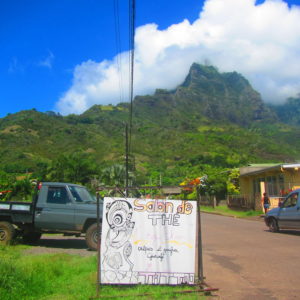
As a side note, all I wanted when I arrived into French Polynesia was a salad, and it wasn’t until Dan and I had lunch together that I witnessed lettuce. Real, green lettuce! We take it for granted in the States, because not only do we have lettuce there, we have Iceberg, Green Leaf, Red Leaf, Romaine, Arugula, Spinach, Mixed Field Greens, Boston, Boston Hydroponic and probably more I am forgetting. What a variety! Ah, spoiled brats we are…but now I am a traveling islander seeking ANY lettuce. Damn, I am not picky. My love for lettuce prompted Dan to volunteer for the “lettuce mission.” On Hiva Oa, we learned that they have a Saturday morning farmer’s market. I use the term “morning” loosely here, because the Farmer’s Market is from 4 a.m. to 6 a.m. In my lexicon, the definition of morning can NEVER include a “4”—that’s night—but I digress. Knowing that despite my avid adoration of lettuce I would still not get up that early, hop into a dinghy, drive into land, tie up, walk to the market and find my precious gem-quality vegetable, Dan offered to go on the lettuce mission for me. And he was successful! He arrived into town by 5:30 a.m. to secure two beautiful heads of green leaf lettuce. From what I heard, 20 minutes later, he would have come up short-handed. No more lettuce even before 6 a.m. Oh, and there have been NO tomatoes in all of the Marquesas (apparently there was too much rain this season because of La Nina), and NO tomatoes in the Tuamotus either (which will be written about in a later entry). Now I miss tomatoes…
Me Repairing Our Jib
Fatu Hiva
After less than a week in Hiva Oa, we opted to do a full day sail down to Fatu Hiva, a beautiful island that Captain Cook sailed to so long ago. Fatu Hiva is considered the lushest of the Marquesan Islands; it is only 10 km long and 4 km wide but packs a punch with a height of 1,000 meters. (All this international travel has me using the metric system much more than I ever did in the U.S. A thousand meters is about 3,000 feet.) We left at about 5 in the morning and arrived mid-afternoon. The bay we anchored in used to be called the Bay of Phalluses, but after the missionaries came through, they changed the name to the Bay of Virgins. Silly, really. The bay was given its original name for a REASON, due to the natural volcanic spikes that seem to “stand at attention” all over the bay. 😉 This was a beautiful bay and finally granted us some fantastic hiking.
We sailed to Fatu Hiva with Barbara Jean and Belafonte, and were joined by several other ARC boats and a few others that were already in the bay. We had an impromptu cocktail party on our boat that evening. Interestingly, we had about 16-18 people on our boat, representing 12 nations, including the French man (Daniel) who had been living on his boat in that bay for about 8 months already. Countries represented were: Ireland, Canada, France, South Africa, Germany, Spain, Italy, Great Britain, Belgium, Poland, and New Zealand, and the United States. How cool is that? That is one part of cruising (especially with the ARC, but not exclusively) I really love—meeting people from all over the world. Being a social psychologist, this part of our trip is nearly as wonderful for me as all of the places we are visiting.
The morning after our cocktail party, a fairly large group of us (ranging in age from 10-70) decided to hike into a waterfall. It was a beautiful hike that took about an hour to reach a lovely, tall waterfall with a cold, deep swimming hole at its base. I am usually a baby with water that cold (think Canada-cold), but it sure did feel refreshing once you got in after the hot hike. The kids and Dan decided to swim under the waterfall too; our family had a great time. We stayed only a few nights in Fatu Hiva and then we decided to do an overnight sail to another Marquesas Island called Nuku Hiva. On the way, we spent a night at Baie Hanamoenoa (Stephen’s Bay) on Tahuata Island. That was a lovely anchorage where several ARC boats were located, included Widago. Widago had a cocktail party that night and invited all of the ARC boats to attend. It was fun and the kids got to hang out again!
The Waterfall Hike on Fatu Hiva
Typical House on Fatu Hiva
Adorable, affectionate kitten on Fatu Hiva
Coprah Production (Drying the Coconuts)
Nuku Hiva
From Stephen’s Bay, our plan was to sail to Nuku Hiva for the ARC rendezvous a few nights later. I did not anticipate having seasickness on this short sail (one night), but I was hit hard. This officially became my first watch that I could not stand entirely on my own since we’ve owned Do Over. I don’t know exactly what prompted this horrible seasickness (we have had much rougher passages) but a Scopalomine Patch could not touch it. I sat at the helm with a few one-gallon Ziploc bags, and got sick about 16 times. We were sailing fairly close to Belafonte and Barbara Jean, and for the first time, I just didn’t think it was 100% safe for me to be at the helm. After two and a half hours, I had to wake Dan up.
I hate that I can no longer say I have always stood my watch. I used to pride myself on that. But I won’t be too hard on myself because it is still surreal to me that I am here in French Polynesia because I sailed here with my family—seasickness and all. That has to be worth something, right? 🙂
Nuku Hiva
Nuku Hiva was a lovely island and we ended up staying there for about a week. Nuku Hiva is actually the second largest French Polynesian Island after Tahiti (with 330 square kilometers). We based ourselves much of the time in Taiohae Bay. Here, A LOT of people from the ARC got tattoos but I am proud to report or sorry to say (depending on your view) that no one from the Gabier clan partook in a new tribal body decoration. Some of the tattoos did look very beautiful though. We had an ARC dinner and a day of the local folks demonstrating their bead jewelry making, basket-weaving and offering up their local fruits for tasting. There was a good restaurant on the island as well, and some Internet! We also had our Genniker sail repaired here by Kevin, who owns the local yacht services company.
Nuku Hiva
Ariana and Ryan making bead necklaces
ARC dinner
One of my favorite photos of the trip: “Chicken in a Bucket”
During our time in Nuku Hiva, we left to go to Daniel’s Bay (Baie de Taioa or Hakatea) for a night, which was only a short sail away. Daniel’s Bay was gorgeous. The scenery was incredible and it was such a quiet and peaceful anchorage. There were a few boats there and we were able to learn more about the incredible waterfall hike. It had rained quite a lot before we arrived so the trails were expected to be very muddy, and the hike itself required crossing a river several times. The hike took you to the Vaipo Waterfall, the third largest waterfall in the world. There were a handful of ARC folks who felt it would be too difficult for Ryan and Ariana to do the entire hike, but they don’t know our kids like we do! We ended up doing the entire hike without any complaints from either of our little progeny—and it was quite challenging. At one of the river crossings, Ryan started to get swept up a bit in the current, but Dan grabbed him and got him across. Sometimes the trail was not well marked, especially after the river crossings, but we managed to find our way to the end of the hike, which resulted in a view of only part of the waterfall and a bunch of waterfall spray. The whole hike was about 4.5 to 5 hours, and EXTREMELY muddy. We were pretty much covered in mud from our knees down until we hit each of the river crossings and could wash it off. One part of the trail, Ariana nearly lost her Keene shoe after she went ankle deep in mud! We also had to keep applying mosquito repellent because those mossies would get fierce near some of the river crossings. Also, there was really no place to sit and enjoy a snack along the way during this hike. Boursin cheese and crackers had to wait—so we had two very incredibly hungry kids when we got back to the locals’ houses. Which brings me to the other wonderful part of this hike. Before we ventured into the plant-filled gardens and forest, we met some of the locals who were interested in selling us their garden fruit. We told them ahead of time what we wanted and they had it ready for us when we got done with our hike. They had so many fruits! Bananas, yellow and green papayas, grapefruit, star fruit, and their “guava.”
Guava is a funny thing, because it seems to be different depending on where you are. Guava in the Galapagos was this very long and thin fruit that you peel and take the insides out and eat—and it is soft and “fluffy” and white. In the Galapagos, Guayaba is what our guava is in the United States. In the Marquesas, Guava is completely different from ours in the United States too. It is about the size of a small orange, you bite into the entire thing and it has about a quarter inch layer of orange color with a deeper core of an even brighter color with many seeds. You don’t peel it, and it is pretty good. Ariana really liked this fruit. So, we met the family’s incredibly cute white kitten and their older cat, and got to see a bit more how folks live out there. Like a lot of families, they made “coprah” which is coconut oil. They harvest their coconuts and dry them out, ship them to the mainland, and it is made into the final product. A few of these families would cook you lunch as well. Some ARC people decided to have lunch, which included a pig roasted in their traditional manner (underground), some rice with coconut milk, and some grapefruit for dessert.
On another night (back in Nuku Hiva), we went to a cocktail party on Paw Paw (Roy and Elaine) with Nina (Steve, Lynda and crew Peter and Karen) and a few non-ARC boats from Australia and New Zealand. That was a very fun night too!
Daniel’s Bay
The Waterfall Hike–Crossing the River
The Third Tallest Waterfall in the World (Vaipo Waterfall)
An Islander’s House
“Guava” in the Marquesas
The Family With All of the Fruit!
Most Random Spot for a Working Telephone Booth

We headed back to Taiohae Bay to have our sail repaired and to provision. After a few more days, we were off to the Tuamotus, which are low-lying atolls in the South Pacific Ocean.
I know, I know, I am slow…
I will be posting again within the next day or so. It will include the Marquesas Islands, the Tuamotus, and a great Drone video we took in Fakarava, Tuamotus. AMAZING waters and diving. I hope all is well and please keep checking for new posts. It definitely encourages me to keep writing when people are reading what I write! 🙂
The LONG sail to the Marquesas: Three weeks at sea.
Three long, long, long, long weeks at sea. One of the first things we did on this passage—only after a day or two—was to change our watch schedule. Everyone has to figure out what works for them, but our four hour watches at night weren’t cutting it. I never felt well rested on passage. Dan and I originally alternated every other night: one night he did 8 pm to midnight and 4 am to 8 am and I did midnight to 4 am, and the next night I took the two watches and he took the one. I don’t mind staying up late (night person) and Dan doesn’t mind the early morning watch (morning person), so we decided to make our schedule permanent, as follows: I did watch from 8 pm until 2 am (6 hours) and he did the 2 am until 8 am (6 hours). Most days I let Dan sleep for an extra 15 minutes or so because I had the luxury of NOT having to get up right at 8 am. Why? Ryan and Ariana handled 8 am to noon each day (2 hours each/alternating each day) and they also handled 2-6 pm between the two of them. (I did the 12-2 pm and Dan did the 6-8 pm.) The kids were never totally alone, as one of the adults would either be awake inside the boat, or dozing outside near them in the cockpit. They knew to call us if a sail was in need of trim or if there was a boat near us on the AIS (which barely happened during the whole 3 weeks).
This new schedule worked out well for us. I felt much more rested and didn’t dread being out to sea for so long. The kids did amazingly well. Ryan did school all but 4 days (it would have been six days of weekends anyway) and Ariana managed to do some—but less than Ryan because she often doesn’t feel as well as Ryan underway. In fact, Calvert has not been a good curriculum for Ariana (it has been fine for Ryan). The only science topic she hadn’t covered previously in her Calvert curriculum was Astronomy. When she finished that, everything else was redundant—the history and the grammar books and assignments were the same too. So, Dan downloaded a physics book for Ari and they have been working on that together (solving equations, etc.). She is also still completing Wordly Wise and Geometry with Teaching Textbooks (which has been a great math program for both of them). Ari and Ryan read a great deal also.
On Day 2 of our passage to the Galapagos, I was terribly seasick despite the fact the first three days were spent motoring south in calm seas trying to reach the wind. I resorted to a scopolamine patch (for the first time) which began to work within a few hours. They work for three days. I used one the entire trip except the last two days of the passage, but as a result, I was no longer seasick. At first, the patch made my eyes a bit blurrier, and a few days it rarely caused a couple of increased heartbeats, but after weighing the pros and cons, I decided it was worth it. I’m pretty sure that anyone who has experienced debilitating seasickness would agree!
The passage was very routine. I dislike routine. A LOT! (I LOVE IT…-Ari) That being said, it was better than having stormy seas and too many wrenches in our day! So, I tried to practice patience most of the time. When we only had 1,000 miles to go, I began to get a bit excited—two thirds of the way through. I read about 9 books on passage, watched a few movies, colored with magic markers in this adult coloring book the kids gave me for Christmas, slept, played Monopoly with Ryan, watched Modern Family with Ari, and cooked. And cooked, and cooked, and cooked, and baked and baked.
I made at least two meals per day (sometimes the kids made their own breakfast or lunch), and I also baked. I made a homemade cinnamon coffee cake, a giant chocolate chip cookie bar, an oatmeal cake, a yellow cake with chocolate frosting, and homemade sour cream biscuits that actually ended up more like corn bread without the corn. I also made naan bread on the grill. The grill. Yes, the grill became my best friend. Our generator had ceased working prior to our leaving the Galapagos. It was something that was to be easy to fix so Dan said he would fix it while we were underway. Unfortunately, it was not just one problem, but two, and we were without our generator for the whole trip. No laundry. And—no convection oven. I still could use the microwave off of the inverter (for heating things—not for more than about 5 minutes at a time total), but I had no real oven. Good thing I already make pizza on the grill out here sailing! Without a generator, we also had to run our engines each day to charge our batteries. We have solar which was great on sunny days when our sails didn’t blanket the sun, but most days, we still needed diesel charging. The generator is much more efficient in charging the batteries compared to our engines, but you have to work with what you have.
Which brings us to the other issues…two days into our trip, Ariana is on watch and informs Dan that there is a little tear in the main sail. Dan went to look minutes later, and already, the small tear is a huge one, going across much of the sail on the seam below the second reef line. So—now we were down to a main sail with a double-reef. We could not fly the full sail, regardless of how minimal our wind was. That was sail problem #1. A few days later we had good conditions for our Parasailor so we hoisted it up. What we didn’t notice (until it was too late) was that the shackle on the Parasailor Guy chafed the jib while it sat there rolled up on its furling. I noticed a rip in our jib. Sure enough, we unfurled it and it was torn. No more jib. That was sail problem #2. We put out our Genniker (our “Silver Bullet” that we blew out on the way to San Blas Islands and had repaired in Panama) and we were making great time. After a few days with the Genniker, the tack blew while I was standing watch at night. I looked up and I didn’t even SEE the sail because it was flying up in the air. I seriously thought we had lost it completely! I screamed down to Dan who rousted from sleep, and we managed to get the sail back down to our bow. But, what a chore…it is so loud when your sail blows off like that. It is also dark. You have to navigate around the boat and up to the bow by connecting and disconnecting your tethers, which further complicates things. So you end up screaming at the top of your lungs in the dark in the middle of the night thousands of miles offshore of any land. Are you jealous yet? Do you wish you were there with us? So that was sail problem #3. In hindsight, I guess we did have some wrenches in our very routine trip; I must be becoming an old salt…
For the last 8 days, we only had the options of a double-reefed main sail or a Parasailor for a mostly down-wind sail. We got VERY lucky. Dan headed nearly due south at the beginning of our trip to get to the wind. (He had looked at the weather wind GRIBs and south looked to have better wind.) It took us three days (traveling at only 3-4 knots the whole time…can you say painful?), but when we hit the wind, it was very consistent and we had only about 5-10 minutes of rain the entire three weeks. We had heard that others on more northern latitudes hit very inconsistent wind speed and direction and had more squalls. On latitudes more south, folks had too much wind. (At over 20 knots of consistent wind, we really need to take our Parasailor down.) Our latitude proved to be the best we could have been on. We began to have 24-hour averages of 6.9-7.2 knots per hour! We also were able to fly our Parasailor for the last week straight—never having to take it down—because our winds stayed consistent even during the night that last week. At the end of our journey, we were very ready for land, which we reached at about 2 in the morning. I will never forget the smell as we neared Hiva Oa. It was absolutely incredible. The air smelled of the flowers of a traditional Polynesian Lei and of clean earth, especially with the light rain that was hitting the island. What a welcoming! The kids were also awake at this point, and once we were anchored, we stayed up for a while despite the late hour, reveling in the completion of our longest passage.
The Stowaway
No one ever thinks it can happen to them. You take off for a long passage—a three week one to be exact—and one day in, a hundred miles offshore and in thousands of feet of water, you find out you have a stowaway onboard. Shocking since this stowaway has been living in your engine filter—and is still alive. Our stowaway was a small, Galapagoan-Ecuadorian, goby or blenny fish. Dan discovered him on Day 2. He must have got sucked up in the intake when we were leaving Ecuador. What to do? If we put a little reef-living guy like that in the deep ocean, it was the kiss of death for him. We had heard that sailing kids often like to keep a fish for a day or two while in port and then release it prior to departure. Well, luckily, I had bought a little mini Beta fish aquarium in St. Lucia for the kids and it came with a small packet of Beta food. Surprised that our stowaway was still alive, we quickly got out the tank, scooped up some ocean water and prepared his new home. When Dan tried to catch him in a cup, he swam back up into the engine outtake. A turn on of the engine forced him back out and we were able to capture him unharmed. Our little guy (“Lucky”) has been living with us since, eating Beta food, one miniscule litter critter we inadvertently scooped up when we changed his water underway (we did that about every two days), and most recently, a bit of dried cat food. (Try finding fish food in these islands! Ha!) We will have had Lucky about six weeks when we release him in Fakarava (Tuamotus) when we arrive there in about five days.
Ecologically, we were a bit concerned about putting a Galapagos fish in waters over 3,600 miles away. What if he were unique to the Galapagos? Well, we reasoned that if Lucky were female, she would have laid eggs by now if she had some. So, Lucky may have to make “new friends” who speak Fish French rather than Fish Spanish, but there is no chance of breeding unless these little guys already live here, which wouldn’t be a problem.
Lucky provided morale to our crew on our three week passage. Whenever we tapped on the top and opened it up to feed him, he would do “the butterfly” as Ariana coined it, swimming back and forth and wiggling his little fins. As soon as we dropped a pellet of food, he would race to the top to grab it and swim back down to his little fake tree or the miniature-sized Leaning Tower of Pisa that Ryan added to his tank from his own souvenir collection. It is nice to have a pet on board!
The kids and I really miss having a pet, actually. We pretty much scope out all stray cats and dogs everywhere we go to pet them and sometimes feed them. There have been some cute strays!
Lucky
How we secure Lucky when we’re sailing…
Passage to the Galapagos and the Galapagos
We had a five night passage to the Galapagos. Since seasickness was at bay for our captain and crew, it turned out to be a decent passage. The seas were favorable and we made decent time. We also crossed the equator! Dan made it very fun for the kids given he is already a “golden shellback” (someone who has crossed the equator at the international date line). We were to become merely “shellbacks” but we still needed the blessing of King Neptune (aka crazy Dan). King Neptune requested our presence in swimsuits on the bow. With music loud and Dan dressed in Ariana’s wizard Halloween costume (among other things), Dan provided rhyming summaries he had written for each of the three of us, made us slather in squid snot (shaving cream) where we were doused with a salt water hose. Good times. A few years ago, I bought each of the kids a coin that celebrates becoming a shellback, and they can have them engraved with the date when we finally reach a place that can do that for them (probably New Zealand).
We were very happy to finally arrive into San Cristobal. The Galapagos have SO many rules in order to go there and that was a bit annoying, so I will start with the bad before I hit the good. I don’t mind rules and regulations if everyone is forced to comply, but that simply is not the case in the Galapagos (which I suspected given a book I had read regarding the Galapagos). Unfortunately, locals get a pass and that may eventually take its toll on the wildlife there. As a sailboat, you cannot have ONE barnacle on your boat bottom. How do they know if you do? As soon as you arrive, they have divers checking your bottom. Dan had donned scuba gear and cleaned Do Over back in Las Perlas, but one boat in the ARC was not clean enough and had to sail back out 75 miles to have their boat cleaned professionally. They inspect your food when you arrive, and some boats had thrown their freshly caught fish overboard before entering Galapagos waters because of this—which ended up being a waste. And back in Panama, we had to permit someone to “fumigate” our boat in preparation for the Galapagos, which in my opinion was ridiculous since we never even tied to a dock in the Galapagos—even to fuel. (They have a fuel boat that comes to your boat to provide you with diesel.) Plus, I am not a fan of who knows what kind of pesticides being sprayed in our boat given it is such a small space and we have kids. But, in the Galapagos, we saw some locals working on their boat who waited for low tide so they could scrape, sandpaper, and paint their boat bottom. Those copper-based paints are TERRIBLE and yet it was all allowed to seep into the water, despite the fact these local boat owners did this in exactly the place where authorities were set up to collect a tourist tax. Ah, the hypocrisy!
Okay, now for the good—and there was a lot of good in the Galapagos. The wildlife was spectacular! We had watched a BBC documentary about the Galapagos and its unique creatures and we were all excited to see them. We visited three islands (San Cristobal, Isabela, and Santa Cruz) and each offered something unique. On San Cristobal, we toured the island with Widago and K1W1 Beanz, visiting an old volcano that was now a lake, a tortoise sanctuary and a beautiful beach. On Isabela, we kayaked and snorkeled on our own right from our boat (one last “bad” thing—locals are allowed to do this but tourists are supposed to hire a guide just to enjoy the water that is right underneath their boats). But here, we saw marine iguanas (AMAZING creatures who have evolved to swim, eat algae off the bottom, and then to secrete the excess salt by blowing it out of their nasal glands), penguins (really, in the wild? I LOVED this), baby reef-tip sharks, blue footed, red footed, and nasca boobies, some beautiful fish, and a surprise for Dan and Ariana… They were snorkeling a bit away from me and out of the darkness this sea lion swam right for them! It caught them by surprise and they were relieved it was merely a sea lion and not one of the sharks hanging out in the bay, especially since just a few days before, Ryan and I saw a 5-6 foot shark jump entirely out of the water as we stood on the stern of our anchored boat. I was so excited! Except then it hit me that this was the same water we kayaked and snorkeled in just a few days before! I am just glad the shark wasn’t going after a person!
And then there were the absolutely insane sea lions. Despite barriers on the stern of our boat (we could barely get over them ourselves to get on the water taxis), the sea lions STILL managed to board our boat. We came home one night and one had gotten onboard, wiggled to our cockpit, jumped up on our cushioned settee and decided to take a nap. And don’t expect them to just leave when you get home and yell at them either. Nope. They have to be chased off! They became quite annoying and it took me a long time to clean that oily, sea lion cushion…
On another day in Isabela, we rented bicycles with Widago and K1W1 Beanz and rode to the “Wall of Tears.” This used to be a prison and the mean prison official forced the prisoners to build this rock wall for no apparent reason. Now, you can hike up above it and catch a gorgeous view of the island and the bay. Here, I had a comfortable bench and about 15 minutes of solitude and serenity while some of the rest of the group opted not to do the hike up and others did a bit more. It was wonderful…
Ariana and Ryan also took a surfing lesson with a local man and the kids from the above-mentioned boats. They had a great time and both managed to get up on their boards by the end of the few hours they spent out there on the water.
On Santa Cruz, our family hired a taxi driver to take us to the caves and the wild tortoise area. That was a nice day. We stopped for lunch at a very local place for chicken, rice, beans and plantains with our driver. Then we went through the caves with the promise that our driver would be waiting at the other end (which he was). Afterwards, we were able to get up close and personal with a few types of Galapagos tortoises, some much older than 100 years! Unfortunately, two of our days on Santa Cruz were taken up by provisioning and trying to get good enough Internet to download Kindle books for our very long passage to the Marquesas. Ugh. I had to make sure I had enough food and drinks for about 30 days (an extra week just in case). I actually kept a log of the meals I made to keep track of the ingredient I had used versus still had and to make sure I used up the veggies and fruits before they went bad. I will save the trip to the Marquesas for another post, however. And I promise not to bore you with the tedious, repetitive, monotonous routine of a three week ocean passage!
Kicker rock from Wizard’s Heel Beach
Ari is not too old for snuggling with her dad…
On our boat…again…
Penquins of Galapagos
Good Produce at the Weekly Market in Galapagos
Blue-Footed Boobies
Marine Iguana swimming
The tunnels and tortoise area
Climbing through the tunnels
Panama City and Las Perlas Islands
Panama City
Panama City was a nice surprise. It definitely exceeded my expectations. It is a modern city that retains its old town elements, and you can find anything you’re looking for there—including a large mall with movie theaters and fast food! We visited the old town, had some lunch and walked around (with Widago and K1W1 Beanz), and another day we hit the mall for a bit of shopping and a movie. We never did make it to the movie, however, since Dan lost Ryan—albeit temporarily. That’s what Nerf does. A ten year old boy sees Nerf guns in a store and can’t help but stop following his father as he went down an escalator. Luckily, Ryan is 10 and not a toddler so he knew what to do and Dan was quickly able to “find” him waiting at the entrance of the store, but it did make us just late enough that we couldn’t catch a movie. He also knew we all planned to meet up at the food court because Ariana and I were shopping separately, so he planned to do that if Dan didn’t meet him there soon.
“New” Panama City
Very cool building!
Could Ariana look any happier? At the mall with Taco Bell…
“Old” Panama City
ARC sponsored Lebanese dinner and belly dancing
Another day we went out provisioning with Henry from Rapscullion. Rapscullion is not an ARC boat but Henry was willing to accompany us in our attempt to find a hardware store (among other stores). We ended up having Dim Sum at a restaurant in the heart of the non-touristy district of Panama City as well. Who knew you could find that there? We also bought a blow-up love seat with two drink holders for sitting on our bow. Aren’t we sophisticated? And with Ariana being fairly obsessed with Modern Family, she told me jokingly that when we return to the States, she’d like to get a really expensive house and a lawn sofa to freak out our neighbors. Our next stop was the Las Perlas Islands which was a full day sail.
Las Perlas Islands
Compared to the San Blas Islands, the Las Perlas Islands were a bit inferior. Maybe I was spoiled with the warm Caribbean waters, but the water in Las Perlas was pretty darned chilly (unless you’re from Canada or somewhere cold!), lacked good visibility, and wasn’t all that picturesque. I will say that we at least were able to find a place to watch the SuperBowl which happened to be on a beach patio with a good-sized flat screen TV with some of the other ARC cruisers on the island of Contadora. The hotel had seen better days, but it ended up being a perfect place to watch the game.
Another resort on Contadora Island, Las Perlas
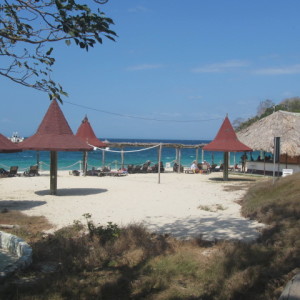
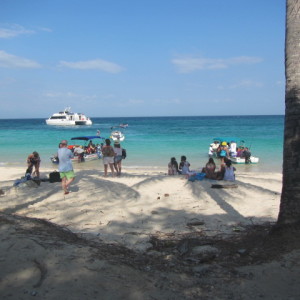
I also spent my birthday in Las Perlas and that was nice. We were anchored at a bay across from Mogo Mogo where Survivor was filmed, and my day started with Ariana and Ryan getting up and making me scrambled eggs and cheese on toast, with a cup of hot tea. This was novel and a pleasant surprise; they don’t usually cook. We also ended up having an impromptu BBQ dinner on the beach with several people from the ARC.
The other positive part of this anchorage was the freedom we were able to give our kids, especially Ariana. It is so amazing to watch them mature before our eyes with the increased independence they are afforded on this trip. Ariana (who has given joyrides to her brother in our dinghy before) motored our dinghy over to three other boats in the anchorage to pick up a total of eight kids (including Ryan). Not only was she able to drive it quite well, but she also had to ensure she pulled up the engine before they reached the beach, and had to enlist the help of the other kids to pull the dinghy and motor up higher on the beach so it didn’t float away. She handled all of that a lot better than I would have! And of course, she had to do the same for kid drop off too. Their goal? They were filming a movie that Ariana had written on her own with only a small amount of feedback from Dan and me. Each child in the ARC played a part and she served as Producer and Director (with William from Widago as co-director and movie editor). We have yet to see the final product, but the rally is supposedly going to show it to the entire ARC when we reach Tahiti. I can’t wait to see it! They also created a satirical news sketch under William’s direction that will also be shown, and is apparently quite funny according to the few folks who have seen it at this point.
Ariana shuttling the ARC “actors.”
Some of the “actors” continuing their filming on Contadora Island.
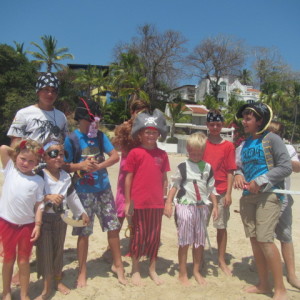
Back at Contadora Island, Ryan got his wish. We ended up coming in first in the multihull division for our trip from Colombia to the San Blas Islands and we scored a bottle of rum. While not a typical award for a ten year old boy, it didn’t seem to bother Ryan (or his parents!). He wants to keep the bottle in his room when we finish its contents…
Panama Canal Here We Go!
What an incredible experience to go through the Panama Canal. I didn’t know all that the transit would entail, but it was quite involved. With the ARC, we had a solid transit date and we were able to “rent” the required lines and fenders as part of the fee we paid. We had a time we had to be near the locks so that we could pick up our advisor and tie up to the other boats who would be with us. In each lock, we had 15 sailboats (five groups of three).
Guillermo was our advisor who came to our boat prior to going through the locks. Your advisor is with you for several hours, and you are required to provide dinner onboard your boat the first evening and breakfast and lunch the next day. There are two locks (Gatun and Miraflores). You complete the first set of locks the first evening and the second set the next day. (It is about 50 miles from the first set to the second.) In between, there is a large, manmade lake where you raft up with other boats and stay until morning. We were rafted up between two monohulls (Time Bandit from Ireland and Toujours Belle from Germany) and one was considerably heavier than the other which made Dan’s motoring more difficult. All in all, it was easier for us in the middle of the three boats because we did not have to catch the monkey fists that were thrown by the Panama Canal line workers to the exterior boats. We also did not have to feed our lines up to the canal workers. Fortunately, I was able to “kick it” and watch everything that was going on around us (except for the meal preparation)!
When we finally got through the second set of locks, the kids and I waved and screamed to all of the people at the Canal Visitors Center (and to the camera that provides a live feed on the Internet). My brother caught the screen shot of it online but it was way too far away to see the crazy people jumping up and down on our bow.
Go Pro screenshot–Ariana and Ryan look like they could have been photoshopped in!
The Lake Between the Locks
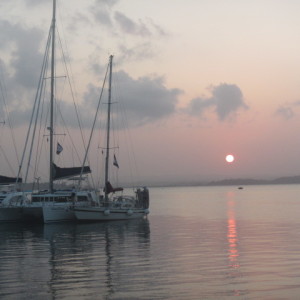
We had watched a documentary on the making of the Panama Canal ahead of time, so it was great for the kids especially to have the historical knowledge as we went through. Ari and Ryan may not be in the classroom right now but they sure are continuing their education—and with firsthand knowledge!
I was curious about the cost of going through the Canal so I imagine readers of this blog are too. Apparently, large ships can pay between $200,000 and $500,000 or more. Cruise ships pay based on the number of people they CAN carry rather than how many they actually have onboard so it makes sense to fill those rooms! I never got an accurate number with respect to a sailboat, and our fee was included with the ARC fee we paid so I am not certain how much it was. One person told me a few thousand dollars, another person told me $800 and yet another said it was only a few hundred (which I doubt highly given the costs associated with clearing in to countries, etc.). I do know that it costs less if you measure under 50 feet (which we do). So, I wish I had a better answer for you, but I was unsuccessful in nailing the exact amount.
